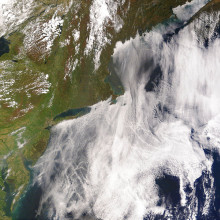We find out what is wind and why do we have it? Plus we ask, why and how do plants always grow upwards?
In this episode

What is wind?
Hannah - So, what is wind and why is it with us? For the answer, we turn to meteorologist and weather forecaster, Jim Bacon from Weather Quest at the University of East Anglia. Jim - The wind is what you feel when the molecules of air start moving. The question is, what makes them move? And this is the point where you can get a clue by listening to Queen's famous song, Under Pressure. Because it's the pressure difference that makes all of these happen. The atmosphere generally doesn't like things to be at a balance. It likes things all even. Just about any feature of the atmosphere would rather be in balance, well, if you go to a place where there's a lot of air above you, the air is denser, the pressure at the surface is higher. And where there's less air above you, the pressure is lower. This is an imbalance and it gives us areas of high and low pressure on the weather maps. And what the wind does is try to smooth things out by taking the air from where there's too much and moving it to where there's not so much. And the result of this is usually to reduce areas of high pressure and fill in areas of low pressure, if it quite achieves it. But the bigger the pressure difference that you start off with between high and low pressure, the quicker the wind wants to flow between them and therefore, you have a stronger wind. Well, it starts off as you might reasonably think, blowing straight from high to low pressure. But because the earth is spinning, other forces come into play, it gets a bit complicated, and in fact, it almost ends up flowing around the highs and the lows, but slightly towards the low. So, it's always trying to fill in the lows. And you could see how fast the wind might be flowing by looking at a weather map because on there, you'll find lines of equal pressure - isobars - and when they're close together, this means there's a bigger pressure difference between the highs and the lows, and therefore, the winds are stronger. In other words, the molecules that make up the air are under pressure to move from areas of high to low pressure.
Hannah - Thanks, Jim. So, it's the Earth's rotations and heat from sunlight that causes air density and pressure differences across the globe and this results in wind.
- Previous What is Random?
- Next BRCA1: Angelina Jolie










Comments
Add a comment